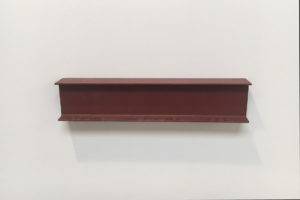Art galleries can be places where the mundane becomes divine, but as the front door of the Honor Fraser Gallery closed behind me, I knew that what I saw was what I was gonna get. In front of me was what appeared to be a selection of various types and lengths of rusty steel I-beams, scattered on the clean concrete floor and leaning against the immaculate white walls, creating the sort of Post Modern scrapyard dreamt of by serious anal-retentives. But hey mon amis, relax those assholes, ‘cause these aren’t actual construction grade, heavy steel I-beams at all; they’re Kaz Oshiro’s “three dimensional replicas… crafted from wood and canvas” and as such, worthy of much more intense consideration.

Well, maybe, if you don’t take into consideration that motion picture studio scenic workshops all over Hollywood are filled with such things. But, I guess the way to differentiate between the two is to give one a title and just call the other a prop; so, you can imagine my confusion when I discovered that each of Oshiro’s 27 “paintings” is actually titled “Untitled”. Unfortunately, that’s how the simulacrum crumbles, and for me the main point of interest shifted from the relationship between the absent original and present facsimile, to the effusive 800-word Honor Fraser press release. Yes, imagine the scenic painter making that canvas I-beam telling their boss that they’re gonna make it so damn perfect that their “degree of effort… will suggest that the success of the Industrial Revolution can be attributed… to the ceaseless work of the exploited laborers adhering to a Protestant work ethic as described by Max Weber in 1905”. Sounds like Union malarkey to me, Chief; better call the Pinkertons before our employees start “meditating on progress”.

Still, there’s no denying Oshiro’s impressive skills; even under microscopic examination these “paintings” appear to be real I-beams. But after that, so what? I’m confused; if, as according to the press release, real I-beams are “emblematic of the rise of an American industrialist class”, then what do Oshiro’s copies represent? Are they emblematic of the rise of an American artist class? I guess so, one that values presentation over content and an artist’s resume over our common history. But then again, fuckit, the commoners have always been impressed by beautiful and accurate depictions of landscapes they’ll never get to see.

Although the sparse installation demands a serious deliberation of each piece, I can’t help but think that any arrangement, even something simple like a sans-serif Joel Shapiro sculpture, would generate more interest; it’s just another example of the disconnect between the sanctioned art world and secular “non-art”. Although no prices are listed, I’ll bet my first-born son (named “Untitled”) that Oshiro’s making way more bank than the dude at Paramount; and all the hype, explanations, and heavy historical references aren’t going to change that Trumpian bargain.


